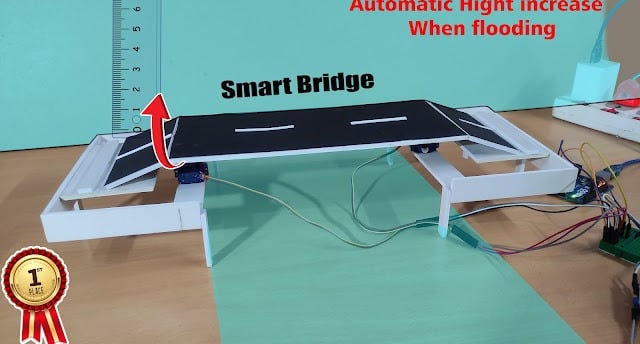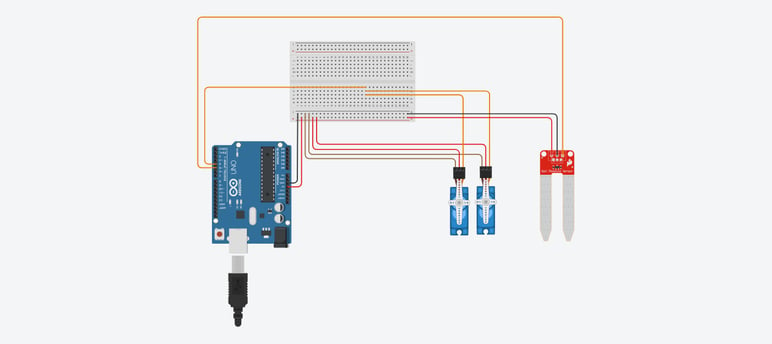Smart Bridge - Automatic Hight increase when flooding | Best science Project
### Smart Bridge: An Innovative Solution for Flood Management **Description:** The **Smart Bridge** is an ingenious engineering project designed to enhance safety and infrastructure resilience during flooding events. This automated bridge system features a sophisticated height-increase mechanism that allows it to elevate itself in response to rising water levels, ensuring uninterrupted transportation and reducing the risk of damage. **Key Features:** 1. **Automated Height Adjustment**: Utilizing advanced sensors and hydraulic technology, the Smart Bridge can detect changes in water levels and automatically raise its deck, allowing vehicles to safely cross above floodwaters. 2. **Real-Time Monitoring**: The bridge is equipped with real-time monitoring systems that continuously assess environmental conditions, ensuring timely responses to potential flooding. 3. **Environmentally Friendly Design**: Constructed with sustainable materials and energy-efficient systems, the Smart Bridge minimizes its ecological impact while maximizing functionality. 4. **Emergency Alerts**: Integrated communication systems notify authorities and the public of imminent flooding, enhancing safety measures during critical situations. 5. **Modular Construction**: The bridge can be adapted for various locations and environments, making it a versatile solution for urban and rural areas alike. **Engineering Principles**: This project incorporates principles from civil engineering, hydraulics, and environmental science, making it an exemplary model for innovation in infrastructure design. Overall, the Smart Bridge represents a cutting-edge approach to flood management, combining technology and engineering ingenuity to create safer communities. This project not only addresses the pressing challenges posed by climate change but also serves as an inspiring example of how modern technology can enhance public safety and infrastructure resilience.


### Smart Bridge: Making Process
The construction of the Smart Bridge involves several critical steps that combine engineering, technology, and environmental considerations. Here's a detailed overview of the making process:
#### 1. Conceptual Design
- Research and Development: Initiate with extensive research on existing flood management systems and hydraulic technologies.
- Design Blueprint: Create detailed designs that incorporate the height-adjustment mechanism, structural integrity, and safety features.
#### 2. Material Selection
- Sustainable Materials: Choose durable, weather-resistant, and eco-friendly materials for both the bridge structure and the elevation system.
- Component Procurement: Source hydraulic systems, sensors, and communication devices from reliable manufacturers.
#### 3. Engineering and Planning
- Structural Engineering: Collaborate with structural engineers to ensure the bridge can withstand heavy loads and extreme weather conditions.
- Hydraulic System Design: Engineer the hydraulic lift system that allows for smooth and rapid height adjustment in response to flood conditions.
#### 4. Construction of Bridge Components
- Foundation Work: Lay a strong foundation, including pylons or supports that will anchor the bridge securely.
- Bridge Deck Construction: Construct the bridge deck using prefabricated segments for efficiency, ensuring they are lightweight but sturdy.
#### 5. Installation of Hydraulic Systems
- Hydraulic Mechanism: Install hydraulic cylinders and other components that will enable the bridge deck to rise and fall.
- Sensor Integration: Equip the bridge with water level sensors and environmental monitoring devices for real-time data collection.
#### 6. Electrical and Communication Setup
- Wiring and Programming: Complete the electrical wiring necessary for the bridge's control systems and safety features.
- Control Systems: Develop the software that will process sensor inputs and control the hydraulic lift mechanism automatically.
#### 7. Testing and Calibration
- System Testing: Perform rigorous testing on the hydraulic system and sensors to ensure reliability and accuracy.
- Calibration: Fine-tune the automation systems to react appropriately to varying water levels and environmental conditions.
#### 8. Final Inspection and Certification
- Safety Inspections: Conduct comprehensive safety assessments in compliance with regulations to ensure the bridge is fit for use.
- Certification: Obtain necessary certifications from relevant authorities confirming the structure meets safety and engineering standards.
#### 9. Installation
- Site Preparation: Prepare the installation site by clearing any obstacles and ensuring access routes are safe for transportation.
- Bridge Assembly: Assemble the bridge at the installation site, connecting all hydraulic and electrical systems.
#### 10. Public Education and Launch
- Awareness Campaign: Educate the local community about the bridge's features and operational protocols.
- Official Launch: Open the Smart Bridge for public use, highlighting its innovative design and benefits for flood management.
### Conclusion
The making process of the Smart Bridge entails a comprehensive approach that integrates modern engineering practices with innovative technology. By following these steps, the Smart Bridge aims not only to enhance flood resilience but also to serve as a model for future infrastructure projects that prioritize safety and sustainability.


### Smart Bridge: Making Process
code
//Arduino Code//
//Code by Harish Projects
//Orde science projects kit & electronics parts from "HarishProjects.com"
#include <Servo.h> //Install this library
Servo tap_servo;
int sensor_pin = 5; //Connect D5 of Arduino
int tap_servo_pin =4; //Connect D4 of Arduino
int val;
void setup(){
pinMode(sensor_pin,INPUT);
tap_servo.attach(tap_servo_pin);
}
void loop(){
val = digitalRead(sensor_pin);
if (val==0)
{tap_servo.write(0);
}
if (val==1)
{tap_servo.write(90); //If you want you can increase & Decrease servo rotation
}
}
